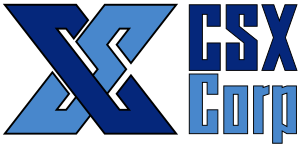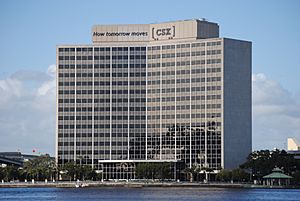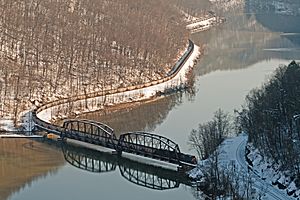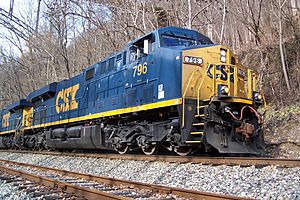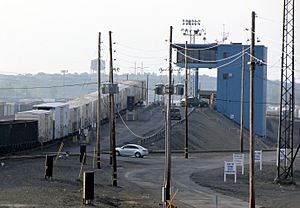CSX Transportation facts for kids
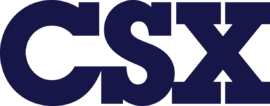 |
|
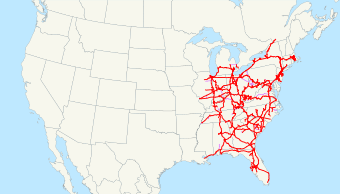
A map of CSX Transportation's train routes with trackage rights in purple, as of 2009. (Some routes are missing and some have since been added or removed.)
|
|
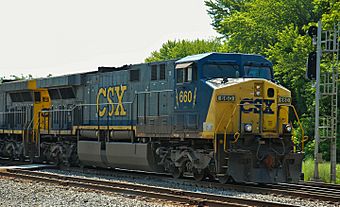
CSX 660, a GE AC6000CW, westbound at Point of Rocks, Maryland
|
|
| Overview | |
|---|---|
| Headquarters | CSX Transportation Building, 500 Water Street, Jacksonville, Florida, U.S. |
| Reporting mark | CSXT |
| Locale | Northeastern, Southern, Midwestern United States and Eastern Canada |
| Dates of operation | July 1, 1986–present |
| Predecessors |
List
Chessie System
Seaboard System Railroad Baltimore and Ohio Railroad Chesapeake and Ohio Railway Western Maryland Railroad Richmond, Fredericksburg and Potomac Railroad Pittsburgh and Lake Erie Railroad Georgia Railroad and Banking Company Conrail Pan Am Railways |
| Technical | |
| Track gauge | 4 ft 8 1⁄2 in (1,435 mm) standard gauge |
| Length | 21,000 miles (34,000 km) |
| Other | |
| Website | csx.com |
CSX Transportation (reporting mark CSXT), often called CSX, is a major freight railroad company. It operates in the Eastern United States and parts of Canada. CSX runs about 34,000 km of track. It is the main part of CSX Corporation, a large company based in Jacksonville, Florida.
CSX Corporation was created in 1980. This happened when two big railroad companies, Chessie System and Seaboard Coast Line Industries, joined together. At first, CSX Corporation was just a parent company. Its smaller railroad companies fully merged by 1987. CSX Transportation officially started in 1986. It took over from the Seaboard System Railroad. In 1999, CSX Transportation bought about half of Conrail. They shared this purchase with their main rival, Norfolk Southern Railway. In 2022, CSX bought Pan Am Railways. This helped them reach more areas in New England.
Norfolk Southern is still CSX's biggest competitor. These two companies mostly control freight rail lines in the eastern United States.
Contents
How CSX Transportation Began
Early Railroads Joining Forces
CSX is the result of many railroads combining over time. The very first of these was the Baltimore and Ohio Railroad (B&O). It started way back in the 1820s. Many railroads on the East Coast began to merge in the 1950s. This was a common trend to make bigger companies.
In 1957, the New York Central and Pennsylvania railroads thought about merging. This led the B&O and the Chesapeake and Ohio Railway (C&O) to talk about joining too. The C&O, which was stronger financially, took control of the B&O in 1962. But both railroads kept their own names for a while. The New York Central and Pennsylvania railroads later formed Penn Central Transportation Company in 1968. This company faced financial difficulties by 1970.
The C&O and B&O together bought shares in the Western Maryland Railway. They took full control in 1967. This brought a third railroad into their group. In 1973, this combined group officially became the Chessie System. It was named after the C&O's famous cat mascot, Chessie.
Southern Railroads Combine
While railroads in the Appalachian region were merging, southern railroads were doing the same. The Seaboard Air Line Railroad and Atlantic Coast Line Railroad decided to merge in 1960. This merger was approved in 1963 and finished in 1967. They formed the Seaboard Coast Line Railroad. This new company also took in the Piedmont and Northern Railway in 1969.
In the Midwest, the Louisville and Nashville Railroad (L&N) also grew by buying other lines. It shared the Chicago and Eastern Illinois Railroad (C&EI) with another railroad in 1969. Then, in 1971, it bought the Monon Railroad. The L&N also bought part of the Tennessee Central Railway in 1969. The L&N had long-standing ties to the Atlantic Coast Line. Other railroads worried about a combined L&N and Seaboard Coast Line system.
In 1969, the Seaboard Coast Line created Seaboard Coast Line Industries. This was a holding company. The Seaboard Coast Line Railroad already owned some of L&N's stock. The new holding company bought even more shares. By 1971, it controlled almost all of them. This also gave them control of the Clinchfield Railroad and Georgia Railroad. These were partly owned by both the Seaboard Coast Line and L&N. The group of railroads started operating under the name "Family Lines."
Forming CSX Corporation
One more big merger was still to come. This was the joining of Chessie System and the Family Lines. To make this happen, the CSX Corporation was created on November 14, 1978. Chessie and Seaboard Coast Line Industries officially asked for approval to merge in January 1979. Other railroads in the area reacted quickly. By April, the Norfolk and Western Railway and Southern Railway announced their own merger plans. The Southern Railway was against the CSX merger at first. But they soon agreed with Chessie and Seaboard Coast Line and dropped their objections.
On November 1, 1980, CSX Corporation officially began. It took over from Chessie System and Seaboard Coast Line Industries. In 1982, the Norfolk and Western and Southern railroads finished their merger. They formed Norfolk Southern Railway, becoming CSX's main competitor.
The Name "CSX"
One of the first challenges for the new company was choosing a name. Leaders from Chessie and Seaboard Coast Line Industries agreed that neither old name should be used. They wanted a new name that showed they were equal partners. Employees suggested many names using "C" and "S."
At the same time, lawyers needed a name for their legal paperwork. They chose "CSC," but another company already used it. "CSM" (for "Chessie-Seaboard Merger") was also taken. So, the lawyers decided to use "CSX" as a temporary name. But the name stuck! In a public announcement, they said "CSX is singularly appropriate. C can stand for Chessie, S for Seaboard and X, the multiplication symbol, means that together we are so much more."
CSX Transportation Begins Operating
Even though CSX Corporation formed in 1980, you wouldn't see "CSX" on trains until 1986. In that year, Seaboard System changed its name to CSX Transportation. On April 30, 1987, the B&O merged into the C&O. The Western Maryland had already merged into the C&O. This meant the C&O was the only railroad left under the Chessie System name. Finally, on August 31, 1987, the C&O and Chessie System merged into CSX Transportation. This brought all the main CSX railroads under one name.
Buying Conrail
Conrail was a railroad created by the government. It started doing well in the early 1980s. The government wanted to sell Conrail to a private company. CSX was interested, but didn't make a bid. Norfolk Southern did. When Norfolk Southern's bid was chosen, CSX worried. A combined Norfolk Southern and Conrail would be a huge competitor. CSX strongly argued against the sale. They said it would create a monopoly.
Conrail's leader, L. Stanley Crane, wanted Conrail to stay independent. He suggested selling Conrail shares to the public instead. This idea was used in 1987, and Conrail remained independent.
But CSX and Norfolk Southern were still interested. In the 1990s, they tried again. CSX made a surprise deal to buy Conrail in October 1996. Norfolk Southern quickly made its own offer. This started a bidding war. It ended in January 1997 when CSX and Norfolk Southern agreed to split Conrail between them.
On June 23, 1997, CSX and Norfolk Southern asked for permission to buy and divide Conrail. Conrail was an 11,000-mile (18,000 km) system. On June 6, 1998, the purchase was approved. CSX got 42 percent of Conrail's assets. Norfolk Southern received the other 58 percent. CSX's rail operations grew by about 3,800 miles (6,100 km) of the Conrail system. These were mostly lines that used to belong to the New York Central Railroad. CSX started running trains on its part of the Conrail network on June 1, 1999. Now, CSX serves much of the Eastern United States. It also has some routes into nearby Canadian cities.
The two companies didn't want one company to control busy industrial areas. These included Detroit, Philadelphia, and northern New Jersey. So, they created Conrail Shared Assets Operations. This company is owned by both CSX and Norfolk Southern. It operates in these areas for both railroads.
Other Important Purchases
CSX bought the Richmond, Fredericksburg and Potomac Railroad (RF&P) in February 1990. The RF&P had been owned by several connecting railroads. It acted as a link between them. Most of these owners eventually became part of CSX. This purchase added a new connection between Alexandria and Richmond. It linked former B&O lines with those of C&O and Seaboard.
The State of Virginia, which partly owned the RF&P, was not happy with the merger. They especially disagreed about Potomac Yard. This was a major train yard in the RF&P system. The yard had potential for new development. As part of talks with the state, CSX agreed to close the rail yard. A deal was reached in October 1991. CSX and the State of Virginia each bought part of the RF&P.
The B&O had used part of the Pittsburgh and Lake Erie Railroad (P&LE) main line since the 1930s. This was through an agreement. The P&LE stayed healthy enough to avoid being included in Conrail. But a big drop in the steel industry in the 1980s hurt the railroad. As local train traffic disappeared, the B&O was running many more trains on the P&LE line than the P&LE itself. When P&LE employees went on strike, the company cut maintenance. This affected CSX's use of the line. CSX became interested in buying it.
CSX tried to buy the P&LE in 1988. This attempt failed. CSX then bought the P&LE main line in 1991. They leased it back to the P&LE. The next year, CSX formed the Three Rivers Railway. It was a new company that bought several key P&LE lines. CSX didn't want the whole railroad. So, some lines and assets were kept by the P&LE's parent company, which later sold them.
Into the 21st Century
In 2008, CSX introduced its current slogan, "How Tomorrow Moves."
In 2014, Canadian Pacific Railway offered to merge with CSX. But CSX said no. In 2015, Canadian Pacific tried to buy Norfolk Southern. Norfolk Southern also declined.
In 2017, CSX announced that Hunter Harrison would become its new chief executive officer. CSX added five new directors to its board. Harrison quickly started changing how CSX operated. He wanted to use a method called "precision railroading." On December 14, 2017, CSX announced that Hunter Harrison was on medical leave. He passed away two days later. CSX's stock price dropped at first. But it quickly recovered. Harrison's successors have continued his changes. Many large train yards were changed to simpler ones. Less busy shipping routes were removed. The number of trains and employees was also reduced.
Buying Pan Am Railways
On November 30, 2020, CSX Corporation announced they would buy Pan Am Railways. Pan Am Railways was a Class II railroad based in New England. The purchase was approved on April 14, 2022. As part of the deal, Norfolk Southern Railway gained rights to use several CSX lines. Also, Pan Am Southern, which Pan Am Railways partly owned, is now operated by a new company called Berkshire and Eastern Railroad. CSX finished the purchase on June 1, 2022.
Buying Meridian and Bigbee Railroad
On June 28, 2023, CSX and Canadian Pacific Kansas City (CPKC) announced plans to buy the Meridian and Bigbee Railroad (MNBR). This railroad creates a 168 miles (270 km) connection. It links CSX in Burkville, Alabama to Meridian, Mississippi. In Meridian, it connects to the Meridian Speedway.
Under the plan, CSX would take over operations between Montgomery and Myrtlewood. CPKC would buy the 50.4 miles (81.1 km) part of the line between Myrtlewood and Meridian. This deal would connect the two companies' networks. It would allow CSX trains going to Mexico to go directly to CPKC. This removes the need for a third railroad to move the trains. Before this, CSX trains for Mexico were given to the Union Pacific Railroad in New Orleans. Union Pacific then took them to Laredo, Texas, where CPKC took over.
In October 2024, the purchase was approved. CSX took over operations on its part of the line. CPKC bought its section. The agreement became official on November 16, 2024. For the next five years, CSX and CPKC plan to exchange about two trains per day in each direction on this line.
The agreement also requires CSX to keep its Selma, AL, connection open. It must also give one shipper access to Norfolk Southern at Selma for five years. The agreement also protects employees affected by the sale. It also requires efforts to reduce noise from the CSX portion.
A few days before CSX and CPKC took over the line, Schneider National announced a new service. Schneider National is a major partner for both CSX and CPKC. This new service connects the Southeast (Florida and Georgia) with Texas and Mexico. It uses the new route between Montgomery and Meridian. This service started in December 2024.
Special Trains
CSX used to run the "Juice Train." This train carried fresh orange juice for Tropicana. It traveled between Bradenton, Florida, and Jersey City, New Jersey. This train was seen as a good example of how trains can compete with trucks for moving fresh goods. In 2017, the long-distance Juice Train stopped. Now, regular freight trains deliver the juice cars to their destinations. It still runs between Bradenton and Tampa.

CSX also operates "Coke Express" trains. These trains carry coke, which is used for steelmaking and making electricity. They run between Pittsburgh and Chicago, and other places in the Rust Belt.
Locomotives (Train Engines)
CSX has rebuilt many of its train engines. Some of their older EMD locomotives have been updated. They now have modern brakes, air conditioning, and new controls. In 2019, 25 SD70AC locomotives were rebuilt. They got new engines and improved controls. CSX has also worked with Wabtec to rebuild GE locomotives. These rebuilt engines have better performance and new electronic controls.
CSX has also gotten some EMD F40PH-2 locomotives. These were previously used by Amtrak. Now, CSX uses them for special executive trains and for checking the tracks. Some of these locomotives were repainted in 2021. They now honor the old Baltimore and Ohio Railroad. Another locomotive, from MARC, was also acquired for similar uses.
After Hunter Harrison became CEO, CSX started storing many locomotives. By January 2018, the company had over 900 locomotives in storage.
CSX ordered ten SD70ACe-T4s in August 2018. They arrived in July 2019. CSX also has a contract with Wabtec to modernize their fleet of CW44s. These modernized locomotives are called CM44ACs. As of June 2020, nearly thirty of these had been updated. In February 2024, CSX and Wabtec made a new agreement. This involves modernizing over 200 more locomotives. These are the rest of their active CW44ACs and CW44AHs. The modernizing will continue through 2028.
On April 30, 2019, CSX showed off locomotives 911 and 1776. These ES44AH locomotives honor first responders and veterans. Another special unit, ES44AH 3194, was shown on August 22, 2019. It honors law enforcement. On September 13, 2022, CSX unveiled SD70AC 4568. It was painted to celebrate Operation Lifesaver's 50th anniversary. On December 31, 2024, CSX unveiled another SD70AC 4720. This one honors their 'One CSX' initiative, which celebrates railroad employees.
Special Heritage Locomotives
In May 2023, CSX started its heritage unit program. The first was ES44AH No. 1827. It was painted to honor the Baltimore and Ohio Railroad. CSX plans to paint a total of 21 heritage locomotives. Each locomotive's number matches the year the honored railroad was founded or its name began to be used.
Safety on the Tracks
In 1995, CSX set a new rule for safety. They required $200 million in insurance. This led to their policy, "no steam on its own wheels." This means they banned old steam locomotives and other antique rail equipment from their tracks. They did this because of safety worries and increased risk.
Train Accidents and Incidents
- 1986: A train derailed near Miamisburg, Ohio.
- 1993: A train accident happened near Mobile, Alabama.
- 1996: A train collision occurred in Silver Spring, Maryland.
- 1997: A train collision in West Virginia resulted in one death.
- 2000: A bus and train collided in Tennga, Georgia. Three people died and four were injured.
- 2001: The CSX 8888 incident happened in northwest Ohio. One person had a minor injury. This event inspired the 2010 movie Unstoppable.
- 2001: A fire broke out in the Howard Street Tunnel in Baltimore, Maryland.
- 2007: A train derailed in Brooks, Kentucky.
- 2011: A train wreck and fire happened in Mineral Springs, North Carolina. Two people died.
- 2012: A train derailed in Ellicott City, Maryland. Two people died.
- 2013: A train derailed in Spuyten Duyvil.
- 2014: A train incident occurred during the filming of Midnight Rider.
- 2015: A train derailed in Mount Carbon, West Virginia.
- 2015: A train derailed in Maryville, Tennessee.
- 2017: A train collided with a tour bus stuck on tracks in Biloxi, Mississippi. Four people died and 44 were injured.
- 2017: Coal cars derailed in a Pittsburgh suburb.
- 2017: A train derailed in Hyndman, Pennsylvania, causing a chemical release and fire.
- 2017: A train derailed in Atlanta, destroying a home.
- 2018: A train collision happened in Cayce, South Carolina. It involved an Amtrak train and a CSX train. Two people died and 116 were injured.
- 2018: A train derailed in Worcester, Massachusetts. It hit a low overpass, causing 12 cars to derail. One car almost hit a car with toxic chemicals. The engineer was injured.
- 2021: A tornado in Barnsley, Kentucky, struck and derailed a CSX train. Several cars were thrown uphill, and one landed on a house.
- 2023: Wildfires broke out in Rockland County, New York. Local officials believe a CSX train caused sparks that started the fires.
- 2023: In Rockcastle County, Kentucky, 16 train cars derailed. Some carried molten sulfur and magnesium hydroxide. This caused a large fire. Residents of Livingston were evacuated. No injuries were reported.
Major Train Yards
In "hump yards," trains are slowly pushed over a small hill. Cars are uncoupled at the top of the hill. They then roll down into the correct tracks for trains leaving the yard.
- Avon, Indiana – Avon Yard
- Cincinnati, Ohio – Queensgate Yard
- Cumberland, Maryland – Cumberland Yard
- Nashville, Tennessee – Radnor Yard
- Selkirk, New York – Selkirk Yard
- Waycross, Georgia – Rice Yard
More to Explore
- Duke Energy Holiday Trains
- History of railroads in Michigan
- List of CSX Transportation lines
- List of CSX Transportation predecessor railroads
- National Gateway
- Railex (refrigerated rail service – CSX and Union Pacific Railroad)
- Union Pacific Railroad
See also
 In Spanish: CSX Transportation para niños
In Spanish: CSX Transportation para niños


